How to Get SEO Clients: 2025 Agency Guide
Learn how to get SEO clients for your Creative Agency in 2025 with 10 proven strategies that actually work. See how top agencies attract and retain profitable clients.




Want to know how top SEO agencies consistently attract and retain profitable clients?
This guide consolidates 10 proven strategies to attract and retain clients from 15 successful agencies, collectively generating over $13 million in annual revenue. From agencies like SEOBrothers ($3.6M/year) to WithContent ($500k/year), I've analyzed their approach to landing and retaining clients—even amid budget cuts and threats from AI.
In this article, I'll explain 10 tactics to get and retain clients for your SEO agency.
The total amount companies spent on SEO services in 2022 was $68.27 billion. This accounts for consulting services, investment in keyword research, analytics, audits, and other SEO tools, SEO content writing and optimization, and off-page website optimization.
Some report that this number will be $88 billion in 2024, despite the budget cuts in marketing spending since 2020. This means that there is enough money to go around for SEO experts, and one way to tap into it is by getting clients who value your expertise and consider you their business partner.
However, there are thousands of small boutique SEO agencies and large multinational marketing corporations, and these are your competitors. These people want a (huge) slice of the market, which means you have to move faster and be creative in how you show value upfront to attract companies that might love your offerings.
This also means you need to phrase your offerings in an appealing way, and you should keep this in mind while reading this article.
Before my first point, it's safe to mention that you should have a website. Use it to write about who you are and how you are different to show your unique angle to prospects. This helps you to show what your agency does differently so prospects can see at first sight that you’re a potentially perfect partner for their business.
With this out of the way, use these practical tips to get more clients:
While some people may say you shouldn't do anything for free, it's probably the easiest way to get your name at the door. I've seen marketing agencies that offer free consultation services to increase SEO leads. Any business that signs up for it gets what they want, but they're also pitched to. See here:
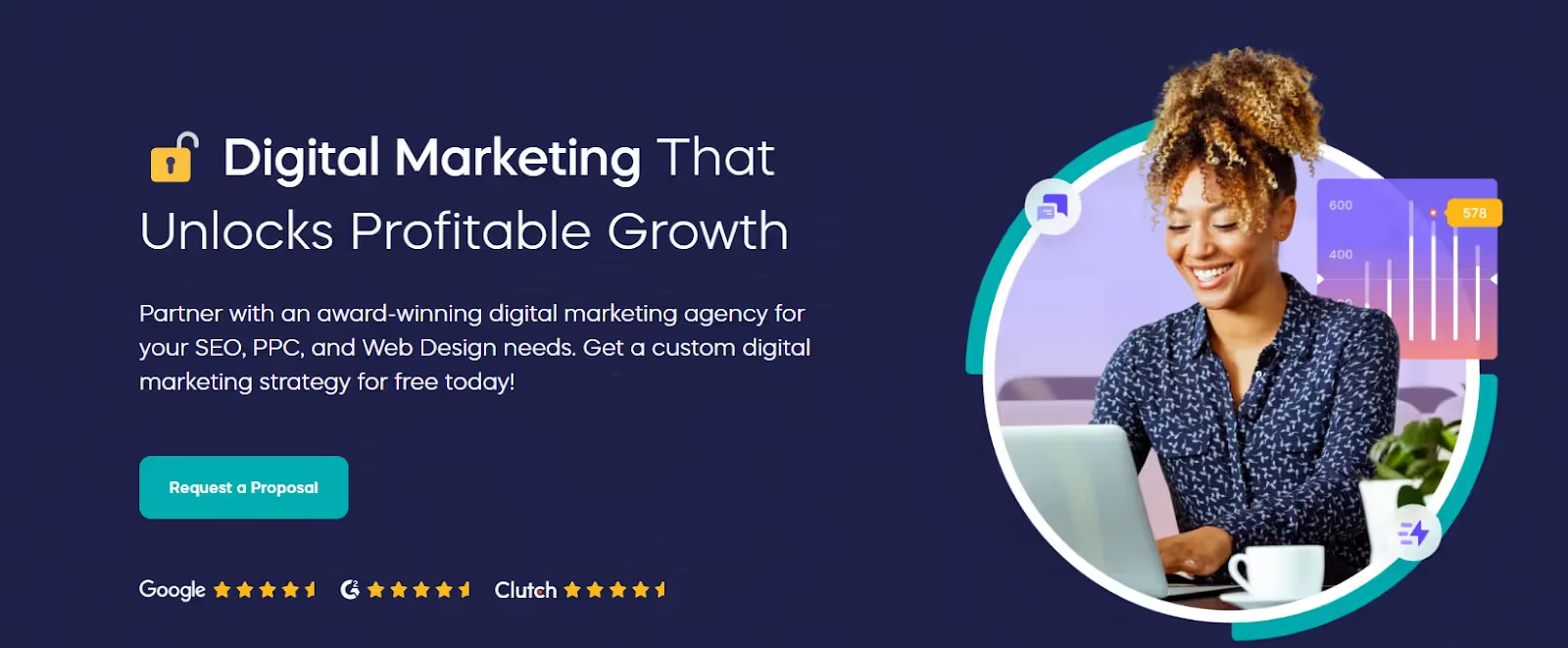
To start, search for a business that isn't doing well with SEO.
Prioritize businesses with enough revenue to hire an SEO agency. When you find them, use a tool like SEMrush or Ahrefs to run an SEO audit. You can also conduct manual audits to find other impediments to their performance.
To choose a business, consider those with over 5-10 years of experience in their industry but with competitors that have more success in SEO than they do. It can even be a startup. To find companies, google any company in your niche and search for their competitors.
If you’re in the fintech industry, that could be Credit Karma. Google “Credit Karma’s competitors.” I found these:

Then, check the traffic volume of these “competitors” on a keyword research tool just to know how they’re performing SEO-wise. This is what I found for Credit Sesame:
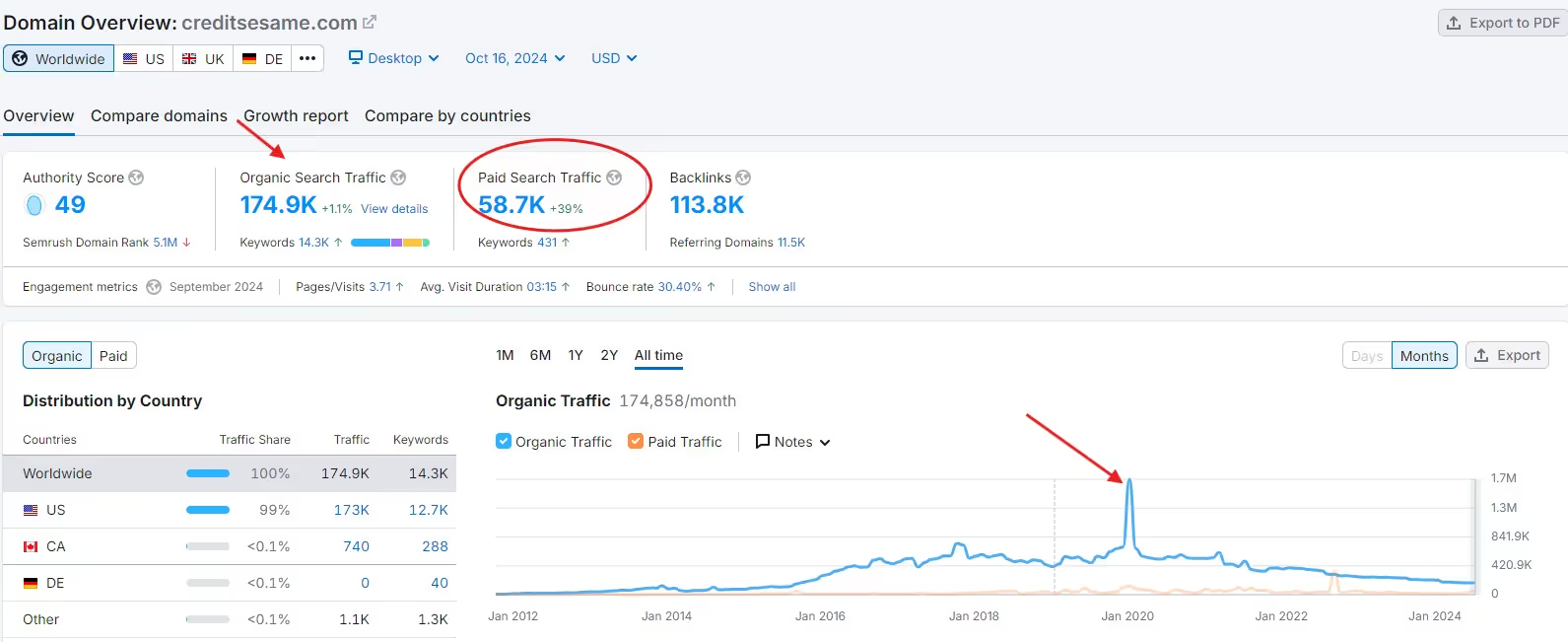
They once had peak traffic (1.7M) and are now down to 174k. They even run paid ads, which isn’t sustainable because it’s more expensive than SEO in the long term. If you compare their domain with Credit Karma’s, the margins are wide:

After this, explore their website via SEMrush or Ahrefs to gather relevant data on why their SEO performance has been declining since January 2020.
Check their content library to see what kind of content they create and compare it to their competitors’ content.
Check their most viewed high-value pages and figure out how to optimize them better (perhaps through content updates, refreshes, or rewrites) to improve traffic and conversion rates that matter to the business.
Be intentional about the businesses you research. I compared other options for about 30 minutes before I chose Credit Sesame as a competitor to Credit Karma. So, depending on your industry and the company, it can take you more time to find the right company to explore. And it will take you much longer to develop a solid strategy for them.
However, when you do, record your screen via Vimeo or Loom. This could be a screen record of a couple of keywords their competitors are ranking for, and the business isn’t ranking for. It could even be keywords from their PPC ads that have high traffic potential (and high conversion intent), but they’re not ranking for on organic search.
Record your screen with this spreadsheet of keywords, the SEO audit report (or any other helpful strategy), and explain how your SEO agency can optimize their web pages to improve organic visibility and CTR. Send it to their email or cold DM them on LinkedIn.
I've tried this in the past. It worked, but it didn’t go through because the client didn't have the money.

Some businesses will have the budget; some won't. But if you hustle this way for a few months and are strategic with the companies you target, you'll definitely attract businesses that will expand your client base.
The goal is to provide value upfront to businesses that can afford your services.
📌 Tip: Read this detailed guide on writing the perfect cold emails and DMs.
You should already have a niche, so I'll roll over this point. I am mentioning it in this article to reiterate the importance of having an area of expertise.
Clients aren't looking for SEO agencies that offer basic writing services. They are looking for a team of experts to become strategic partners for their content marketing operations.
📌 Tip: To learn more about how to choose a niche and better position your agency, read points 1 and 2 in this article.
Brian Dean of Backlinko said he partnered with a design agency when he started his backlink-building agency. This partnership was strategic for him because it helped him connect with clients he would probably not have known without the referral.
You can also partner with other agencies that provide services different from yours. These could be a
In Brian's case, he paid the agency a commission for every lead who became a client. The design agency also talked about him as an SEO expert to their clients— this dramatically reduced the barrier of “pitching” the prospect.
They already trust him; they just need to be certain that his ideas fit their current strategy and business needs.
Having a reliable network of experts is great for this strategy.
If you don't have people you can reach out to in your circle yet, position yourself as a credible SEO agency in public and network with agency owners in private.
They would mention you to their client, and if the client has content needs, it's a win-win for everyone involved. You can either pay the agency a flat fee for each referral, pay a commission, or structure the incentive any way you want.
📌 Tip: Read this helpful resource to learn how to network better
Case studies are testimonials to show that you know what you're doing. If you don't have clients in your agency yet or your clients are yet to have valid, publishable results, use the clients from your freelancing or consulting days for your case studies.
If you achieved these results while working with a team, write a call-out at the top of the page. It doesn’t stop you from writing how your specific contributions led to bottom-line results. Here’s an example:

When you explain how your contributions helped achieve the results, potential clients will see how you can specifically help them.
An addendum to this is that you should not shy away from writing your specific keyword research or writing process that has helped previous clients.
I've seen SEO consultants who recorded a Loom video of how they compared competitor data to help their clients create a better strategy to dominate the search results. Here’s an example of a content ideation walkthrough process that Sarah Colley did.

I've also seen SEO agencies do deep breakdowns of SEO, PPC, and social media branding strategies used by the fastest-growing SaaS brands in the world. An example that comes to mind is Foundation Marketing:

You can use this strategy to flaunt your expertise in SEO and content strategy. Prospects who stumble on these pieces will see the depth of your knowledge and may want to hire you because they believe you.
Lastly, you need to distinguish your SEO agency from others.
This could be through your niche, like rankings.io, the SEO agency of choice for personal injury law firms
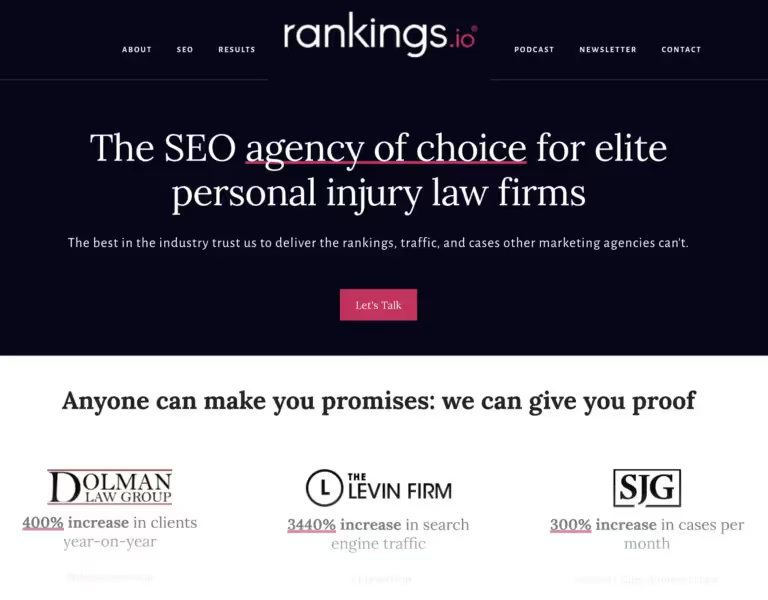
Or through your approach to content writing, content strategy, or content distribution like Foundation Marketing:
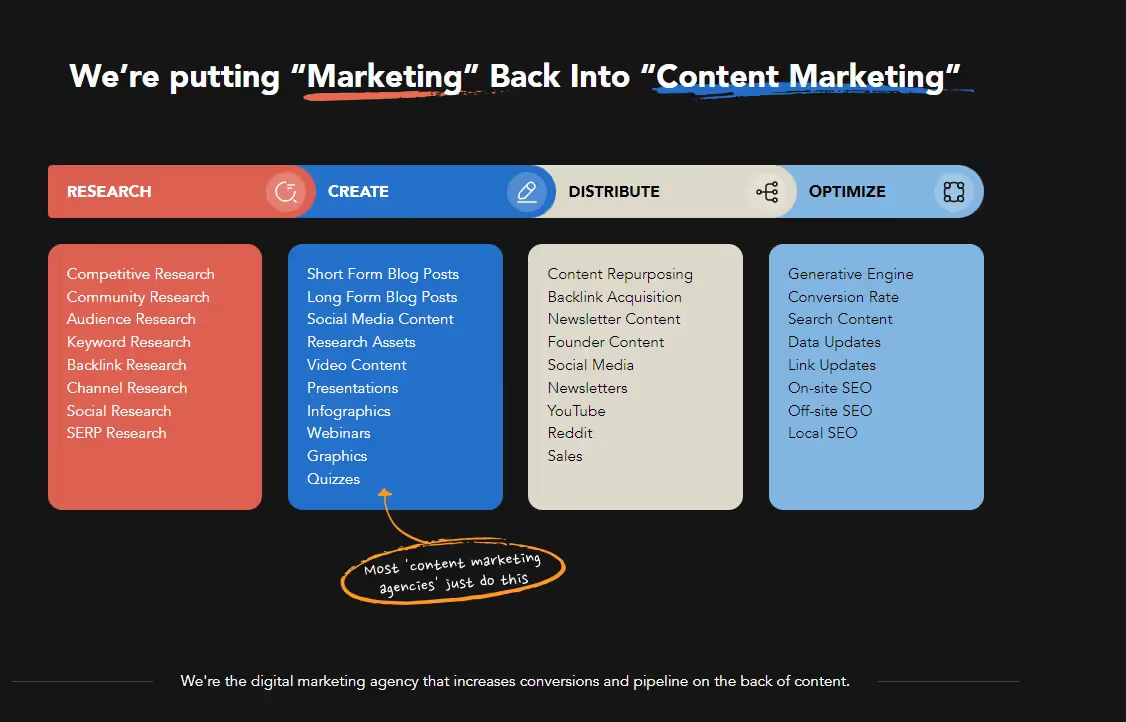
Whatever it is, distinguish yourself and be intentional about your website content.
Tip: How to write case studies that close deals
You want to create posts that can get you in front of potential clients. This means staying visible by creating content that matters to them. A client I once talked to about a project reached out when they saw one of my LinkedIn posts. They said they like it and that it keeps me at the top of their mind.
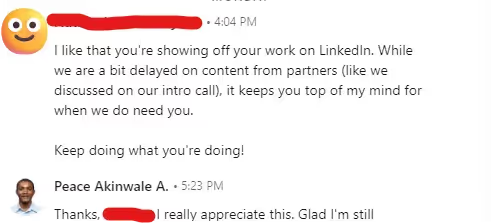
There are many agencies like yours, and one of the ways to stay relevant is to create social media content on relevant topics regularly.
This doesn't mean you should post anything that crosses your mind. It means you should have an opinion, and it doesn't have to be every day.
You can publish once a week— but make it something intriguing, something people can have takeaways from.
If you prefer long-form over short-form content, publish blog posts, podcasts, or start a newsletter.
The people at GrowandConvert publish blog posts regularly and share snippets in their newsletters and on LinkedIn. Here’s a screenshot from their newsletter:

The people at Animalz do the same.
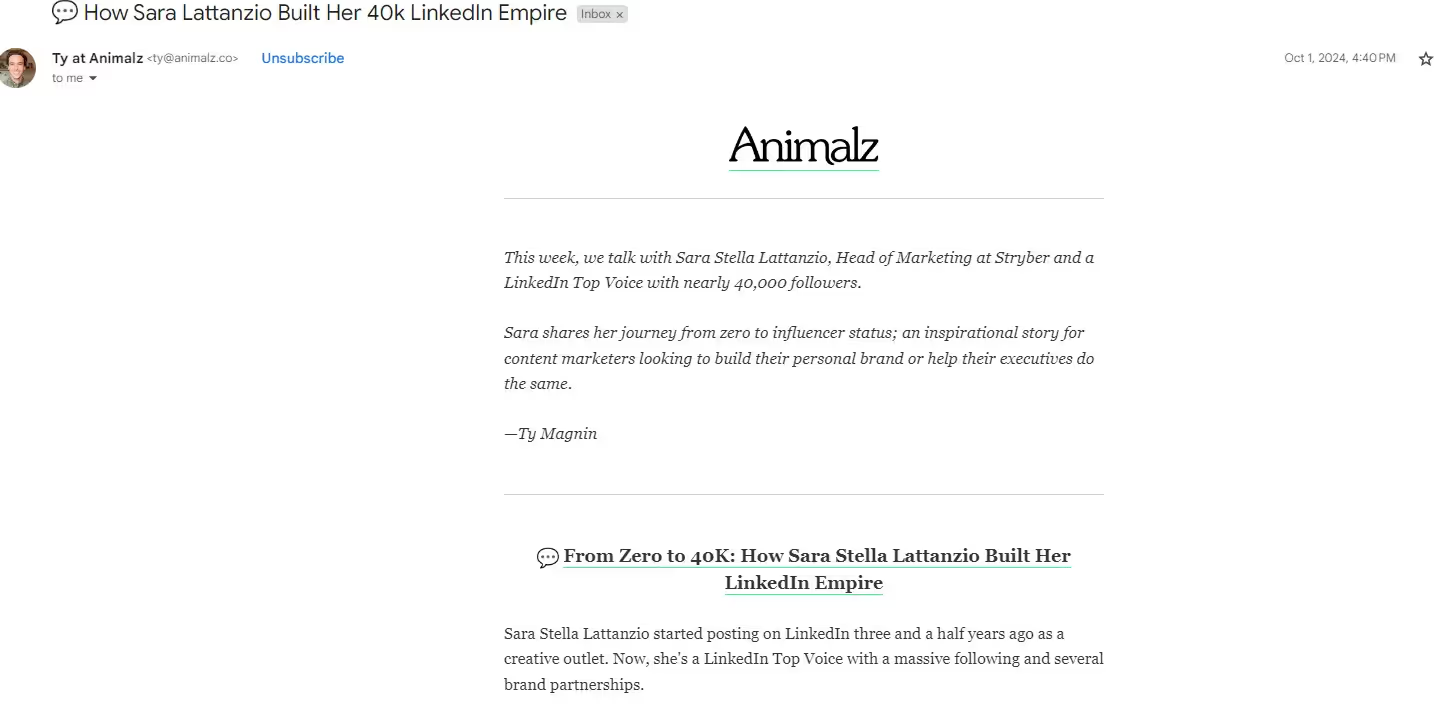
Siege Media's founder also creates podcasts (and blog posts) on SEO and marketing strategies and shares them on LinkedIn.
Here’s an overview of their podcasts and videos:

Here’s a LinkedIn post about one of their blog posts:
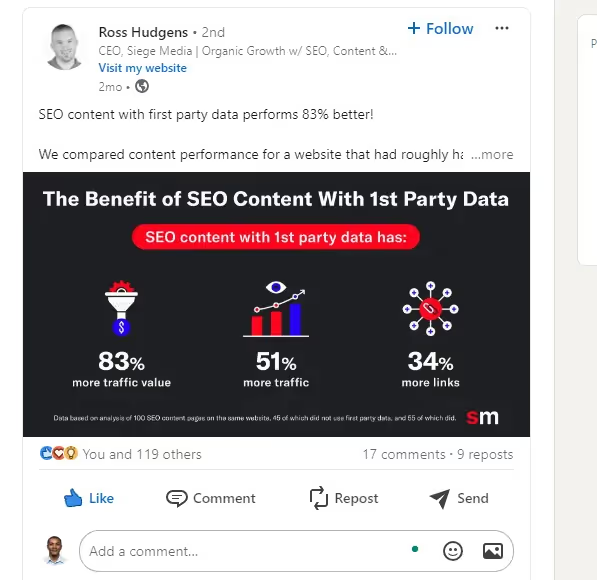
You can also use newsletters, like Foundation Marketing and other agencies do.

After publishing an episode or a blog, share every publication on social media, including the key takeaways. See this:
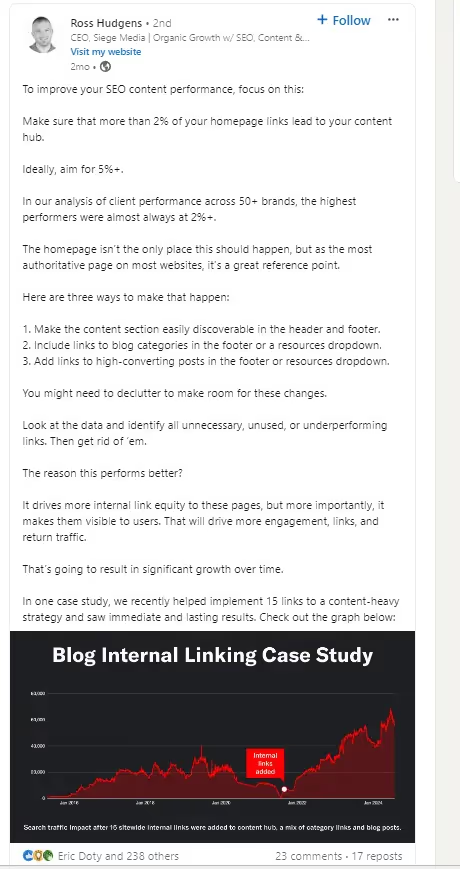
This will attract potential clients who will get acquainted with your content and can contact you if they need your expertise.
However, it helps to be consistent with this as this strategy won't convert immediately. However, if you do it long enough, you'll see results.
📌 Tip: Learn to create thought leadership content on LinkedIn here. You can also read this post to know how to repurpose blog posts on LinkedIn.
LinkedIn and Twitter are great places to start. You'll see heads of one-person content teams, e-commerce business owners whose businesses have started to gain traction, and tech founders who just got funded and need to invest in SEO and branding.
Reach out to them, but don't send cold DMs like this person:

Or this person:
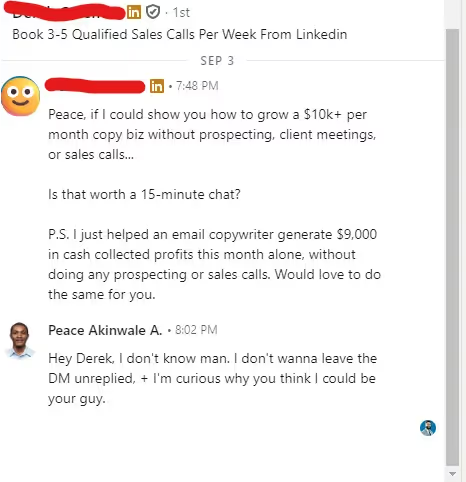
Obviously, these people didn't check my profile or know enough about me before they pitched their services. Instead, be like Brooklyn Nash, who got a $50k/y business from a cold DM.
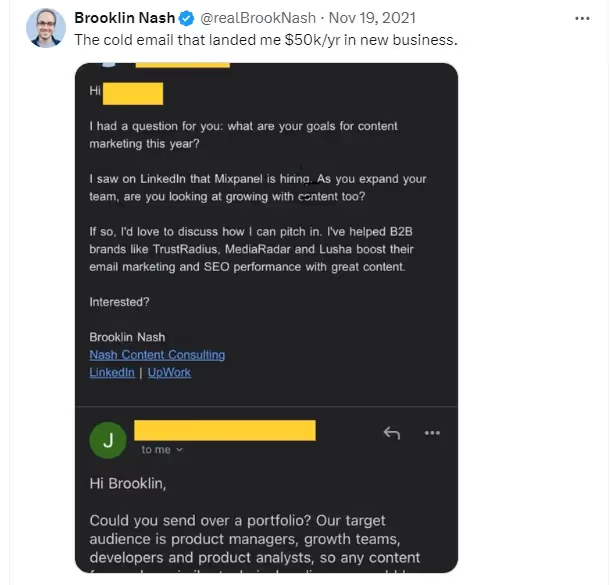
He knew what was up in the prospect’s company, which is how he piqued their interest.
One of the best ways to cold DM or pitch your service is to provide value first. This is why sending a free SEO audit or an overview of a more effective SEO strategy can be effective.
📌 Tip: Samantha McKenna built an 8-figure business through cold emails; read her 7 elements of perfect cold emails and DMs.
This doesn't have to be as grand as having a rate card. It's about having a transparent pricing strategy (or a range of prices) to show prospects what you charge. You can use the service catalog on ManyRequests to create the perfect service and pricing packages.
Through ManyRequests, you can write details on what each service entails and add the price attached to each package. Here's an overview of some services created on ManyRequests:

You can also generate a link to these services to share with your SEO leads or embed on your website.
When clients open the link, they'll see full descriptions of the service and understand what you're charging them for. You can learn more about this feature here or sign up for a 14-day free trial to play with it.
You can design your pricing packages like this example from VEC Studio:
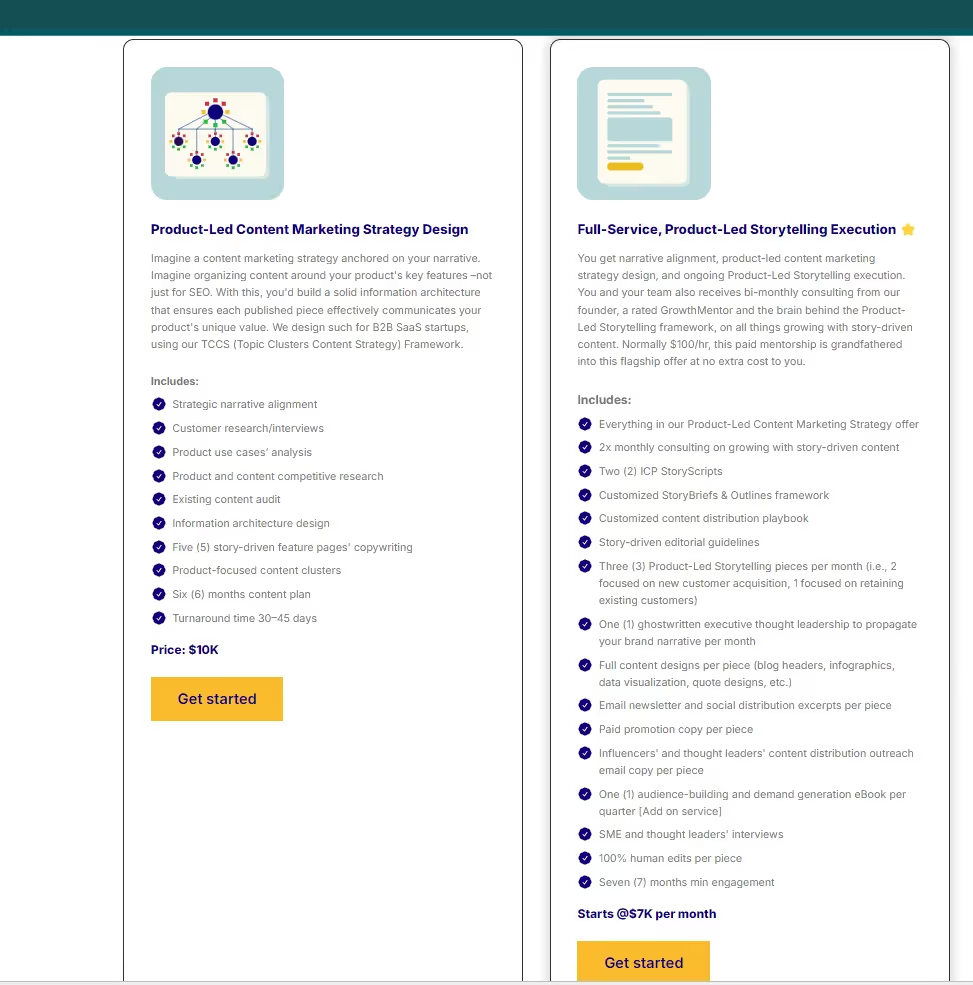
Here's another example from Brian Dean:
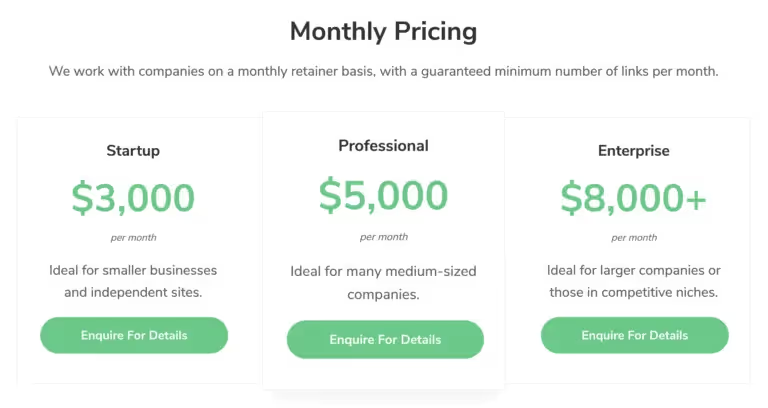
Having different pricing categories gives your clients options to choose from. And if you break down what each price category comes with, you give them more context to the deliverable of each category.
Here's another example from Fraser McCulloch:

For clients who are comparing agencies, transparent prices can help them to decide and convert faster.
📌 Tip: Read this article on various pricing models for SEO agencies.
The keyword “ecommerce SEO agency” has a 8k+ global search volume on SEMrush.

“Enterprise SEO agency” has over 2k search volume:

Clearly, there is demand for the services you offer. While some clients may find you through referrals, social media, podcasts, or newsletters, some clients will find you through organic search.
This is why you should optimize your website with niche or service keywords to increase your visibility and chances of converting prospects.
To start, check the specific keywords they use to search your business on SEMrush or Ahrefs. You can do an organic research analysis of one of your competitors to see the business keywords they're ranking for. This is Siege Media, and one of the keywords they rank for is “b2b digital marketing agency”.

Choose the keywords that best describe your SEO agency and optimize some of your pages for them.
Here's an example from HigherVisibility ranking for “SEO agency for franchise brands.”
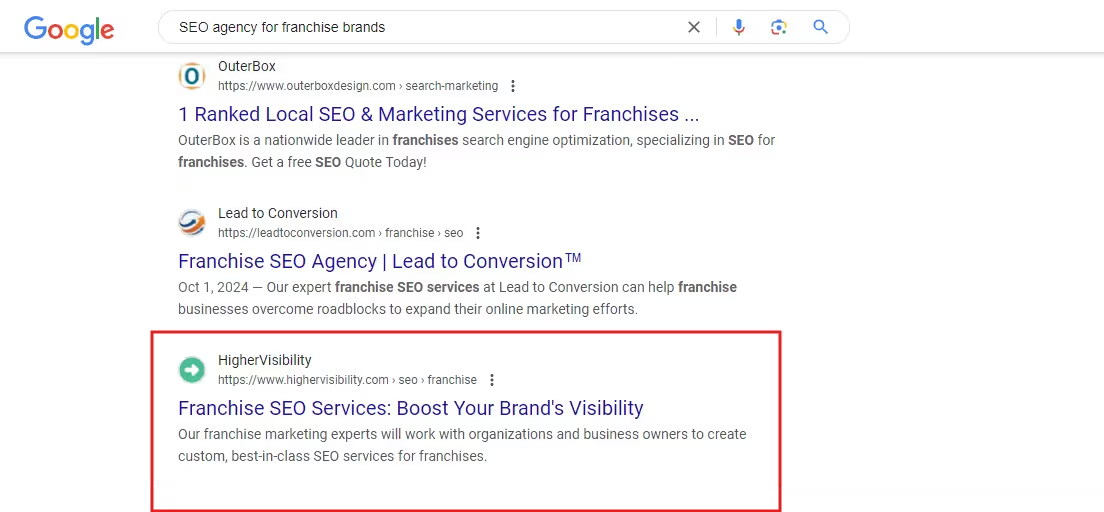
Here's Foundation Marketing ranking for “SEO agency for content distribution.”
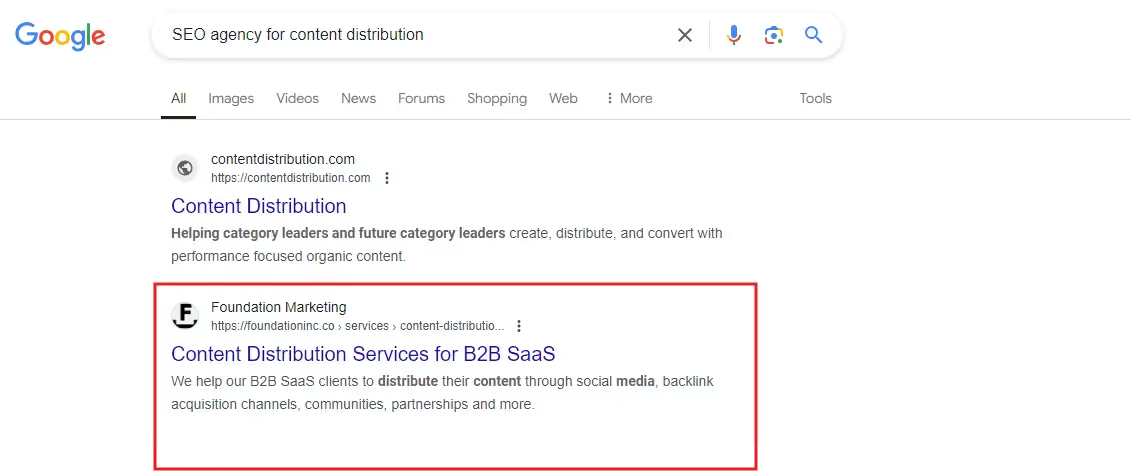
Use these different keyword variations to increase your agency's visibility.
📌 Tip: Read this article to know how to manage client expectations. It can improve your chances of choosing the right price and converting them.
Clients who become “friends” are happy to refer you to other companies who might need your services.
However, it's okay to know that some clients won’t want to refer you, but some clients will definitely say yes. So, ask.
A good time to ask could be after a month's deliverables. Email the client stating that you have the capacity for two more clients for the next quarter and that you wouldn't mind if they mentioned you to any of their friends/colleagues who need (specific) services.
If you feel generous, you can offer an incentive—a 10% discount on the next month's income if their referral brings business to your agency.
You can also leave a portion of your website to incentivize people who refer clients to you as this agency does:
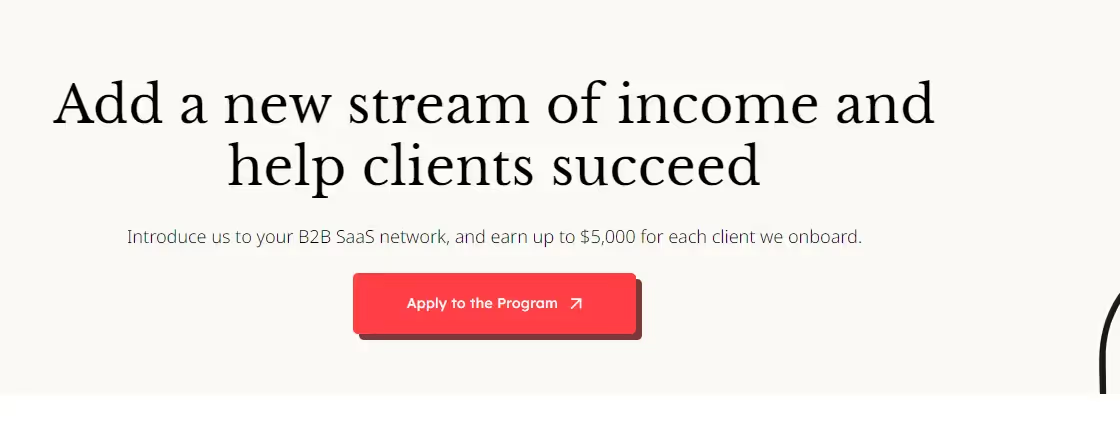
📌 Tip: Read this article to learn how to get more SEO clients for your agency.
Retaining clients will increase your success rate, and the least you can do is anticipate their needs. You already have access to their Google Analytics, and you know the performance of their current content.
You also know the volume of conversions they have and the sort of goals they're interested in targeting.
Anticipate their needs and offer advice on what to do next. You can do this while designing the next quarter’s content strategy. You can also do this after you (they) hit a major milestone—maybe the sign-ups that converted to paid users reached a specific number.
When you anticipate their needs and provide a strategy that meets those needs, they'll consider you a more reliable partner than an SEO agency. Other things that can help you retain clients are:
Be transparent about the content strategy and direction you want to take their website. This will help them understand what you're doing and assure them that you're not using any shady SEO strategies.
Learn to write performance reports that focus on the metrics that matter to the client. This is why you need to know their specific business goals; it will guide you in creating the kind of content they need to get to achieve their business goals.
Use a tool like Hotjar to view heat maps on their website. You can also use Google Analytics 4. These tools help you see where visitors are dropping off or which areas of their page get the most traffic so you can further optimize them for conversion.
Your internal workflow can help you increase the quality of your content. It could be as minute as improving the quality of your briefs and providing expert interviews for each article you assign. Here’s an example of a brief Beam Content uses:

📌 Tip: Read this article to learn other client retention strategies.
Schedule a Discovery Call → Ask them relevant questions → Send a contract → Start work.
When a company says yes, schedule a call to talk about the grand strategy for their business. You can run them through your marketing proposal using this template or discuss the strategies you have in mind based on data.
Before this, you can ask them relevant questions such as:
Asking these questions signals that you're interested in their opinions; it also prompts you to design a custom strategy specifically for their business.
When they are aligned on strategy and pricing, send them an SEO contract. You can use this template to create a retainer agreement to kickstart your professional relationship.
When everything is agreed and signed, start work.
An efficient way to work with retainer clients is to use a client portal to onboard them. Using the ManyRequests portal, you can use the white-labeling feature to create a brand experience and manage client projects alongside your team members. This means that within a single dashboard, you can:
With ManyRequests, you'll get a client portal, a project management tool, and an invoicing feature in one software. Sign up for a 14-day free trial to learn how these features work. If you need help understanding any feature, visit the Help Center.